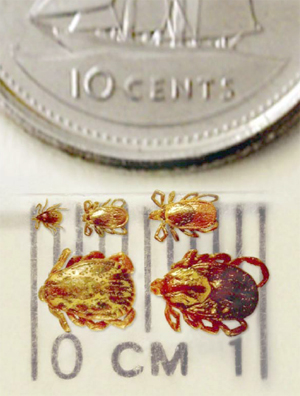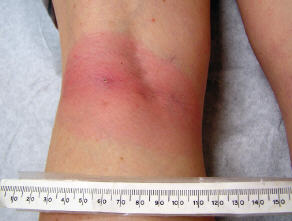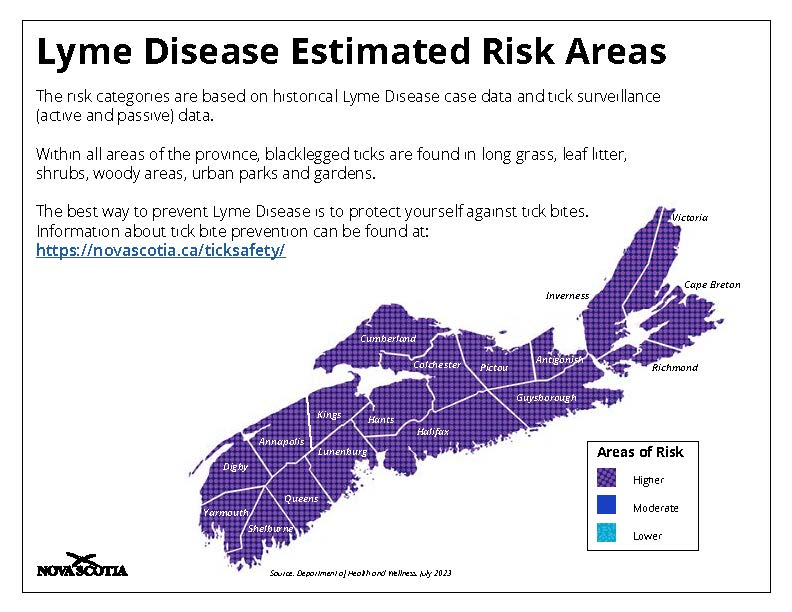
Communicable Diseases - Lyme Disease
Communicable Disease Prevention and Control
Tick Borne Diseases
Tick populations are growing across Nova Scotia. The black legged tick, found throughout the province, is known to spread infections, such as Lyme Disease, Human Granulocytic Anaplasmosis (HGA), Babesiosis, and Powassan virus.
Blacklegged ticks survive best in areas that provide a moist habitat and are often found in and near wooded or forested areas, shrubs, long grass, leaf litter, urban parks, and gardens. Adult blacklegged ticks are most active in the spring and fall. They remain active until the temperature is consistently below 4°C. Larvae and nymphs are most active in the spring and summer.
Rates of reportable tick borne diseases in Nova Scotia are included in the most recent notifiable disease report, which can be found here. Lyme disease is considered established in Nova Scotia, meaning we do not expect it to go away, and rates of anaplasmosis are increasing. Sporadic cases of babesiosis have been reported. No human cases of Powassan virus have been identified.
How can you protect yourself from tick borne diseases?
Nova Scotians are encouraged to spend time outdoors, be active and remember to protect yourselves against tick bites, which is the best way to prevent tick borne diseases.
There are several ways to prevent or reduce contact with ticks when in areas with long grass, shrubs, leaf litter, woods, urban parks, and gardens.
Reduce the risk of having a tick bite:
- Use insect repellents safely. Read the product label carefully and follow directions on the package, it should state ‘for use against ticks’ on the product label. More information on approved insect repellents can be found here.
- Permethrin treated clothing repels and kills ticks when they come in contact with it and is registered for use in Canada for those 16 years of age and older.
- Wear light-colored, long-sleeved shirts and pants, closed toe shoes.
- Tuck shirts into pants and tuck pant legs into socks.
- Walk on well-traveled paths, avoiding high grass and vegetation.
Reduce ticks around your home:
- Keep lawns mowed short.
- Remove leaf litter.
- Put playground equipment in sunny, dry places, away from wooded areas, yard edges, and trees.
- To access more information about simple landscaping techniques to reduce the number of blacklegged ticks around your home, please see the Landscape Management Handbook.
Remove ticks as soon as possible:
- Check yourself, your family, and pets after being in grassy or wooded areas.
- Check clothing and inspect skin including in and around ears, arm pits, inside belly button, groin, around the waist, and especially in hair and scalp area.
- When possible, take a bath or shower within two hours of being outdoors. This makes it easier to find ticks and washes away unattached ones.
- Put clean and dry outdoor clothes in a dryer on high heat for at least 10 minutes to kill any remaining ticks.
- Use clean tweezers to remove ticks as soon as they are found.
- Carefully grasp tick as close to the skin as possible and pull the tick straight out.
- Clean the bite area with soap and water or alcohol-based sanitizer.
- Record the date and location of the tick bite. This information is important to provide your healthcare provider if you start to have symptoms.
- Contact your primary care provider or pharmacist to be assessed for a medication to prevent Lyme disease from. Learn more at: https://novascotia.ca/dhw/pharmacare/healthcare-services.asp.
How do you identify a blacklegged tick?
This chart shows what different types of ticks look like, including dog ticks and blacklegged (deer) ticks which look similar and are both present in Nova Scotia. Visit etick.ca for more information on submitting a tick for identification.
The image below shows a comparison between the blacklegged tick and a dog tick.

Top row: nymph, male and female blacklegged ticks. Bottom row: male and female dog ticks. The blacklegged tick does not always have black coloured legs. Dog ticks usually have white or silver coloured spots.
Photo reproduced with permission from the Public Health Agency of Canada
Human Granulocytic Anaplasmosis (HGA)
Lyme Disease
Lyme disease is a bacterial infection transmitted to humans by a bite from an infected blacklegged tick. In Nova Scotia, only the blacklegged tick carries the bacteria that causes Lyme disease, and not all blacklegged ticks carry the bacteria.
Ticks attach to the skin and feed on blood. In most cases, a tick carrying the bacteria that can cause Lyme disease must attach and feed for at least 24 hours, often 36-48 hours of attachment before the bacteria can be transmitted.
Lyme disease cannot be transmitted by touching, kissing or being near an infected person.
Primary care providers and pharmacists can assess the risk and prescribe an antibiotic for the prevention of Lyme disease. Learn more at: https://novascotia.ca/dhw/pharmacare/healthcare-services.asp
Where are the areas of risk for Lyme disease in Nova Scotia?
Blacklegged ticks are found throughout Nova Scotia and all areas of the province are considered as higher risk of Lyme disease. The following is a Lyme disease estimated risk areas map that uses historical Lyme disease case data and active and passive tick surveillance data to show Lyme disease risk by county.
The risk area categories are based on historical Lyme disease case data and tick surveillance (active and passive) data. Within all areas of the province, blacklegged ticks are found in long grass, leaf litter, shrubs, woody areas, urban parks, and gardens. All areas of the province are considered as higher risk of Lyme disease.
What should you do if you think you have Lyme disease?
Tick bites are often painless, and you may not know that you have been bitten. Symptoms for Lyme disease typically appear 3 to 30 days after you have been bitten and may include any of the following:
- Rash (sometimes shaped like a bull’s eye)
- Fever
- Chills
- Headache
- Fatigue
- Aching muscles and joints
- Swollen lymph nodes
More severe symptoms (experienced weeks to months after a tick bite and no antibiotic treatment taken) may include but are not limited to:
- Severe headaches
- New skin rashes
- Facial paralysis (such as Bell’s palsy)
- Irregular heartbeat
- Joint pain
- Nervous system disorders (such as dizziness, confusion, or inability to think clearly, and memory loss, nerve pain, numbness or tingling in the hands or feet)
If you have recently been in a grassy or wooded area and have symptoms suggestive of Lyme disease, especially if they include a bull’s eye rash, you should seek prompt medical attention. Effective May 1st, 2024, pharmacists have been authorized to assess and prescribe treatment of early Lyme disease as outlined by the Infectious Disease Expert Group. This will increase accessibility for individuals who meet the criteria for prevention and treatment of Lyme disease.
The following pictures show examples of this rash:

A bulls-eye rash (Erythema migrans) is a typical symptom of Lyme disease.

The rash associated with Lyme disease is not always in the typical bulls-eye shape.
Photos reproduced with permission from Dr. John Aucott, Lyme MD, Lyme Disease Research Foundation
Where can you find more quality information on Lyme disease?
Here are some reliable sites that can help answer your questions:
- https://www.canada.ca/en/public-health/services/diseases/lyme-disease.html
- https://www.niaid.nih.gov/diseases-conditions/chronic-lyme-disease
- https://www.cdc.gov/lyme/faq/index.html
Human Granulocytic Anaplasmosis (HGA)
Human Granulocytic Anaplasmosis, often referred to as anaplasmosis, is a bacterial infection transmitted to humans by the bite of an infected blacklegged tick. In recent years, there has been an increase of laboratory confirmed reports of anaplasmosis in NS. Anaplasmosis became a notifiable disease in Nova Scotia in May of 2023.
What are the symptoms of anaplasmosis?
Anaplasmosis symptoms generally appear 5 – 21 days following the bite of an infected blacklegged tick. The first symptom is typically fever, followed by one or more of the common symptoms including:
- chills,
- headache,
- muscle aches and
- joint pain.
Most cases are mild and self-limiting with all symptoms typically resolving within most patients within 30 days however, severe illness is possible. The risk of anaplasmosis infection can be lowered by preventing tick bites and illness can be successfully treated with antibiotics.
Co-infection with other tick borne diseases such as Lyme disease is possible.
Babesiosis
Babesiosis is caused by a parasite spread to humans by the bite of an infected black legged tick. There has been sporadic human laboratory confirmed reports of babesiosis in Nova Scotia over the last several years. Babesiosis became a notifiable disease in Nova Scotia in May of 2023.
Some people infected with babesiosis have mild symptoms or don’t experience any symptoms at all. Babesiosis may cause a more severe infection for individuals who have compromised immune systems including older adults, and individuals who do not have a spleen or have serious liver or kidney disease.
What are the symptoms of babesiosis?
Babesiosis symptoms usually appear within 1-4 weeks following a bite from an infected blacklegged tick. Symptoms experienced can include:
- Fever, chills
- Sweats
- Headache
- Body aches
- Loss of appetite
- Nausea
- Fatigue
Powassan Virus Infection
Powassan virus infection is a viral infection spread to humans through the bite from an infected tick. Three types of ticks can spread Powassan virus, the blacklegged tick, the groundhog tick, and the squirrel tick; the blacklegged tick is the most common species of these ticks found in Nova Scotia. Powassan virus has been identified very sporadically in ticks found in NS, 1 blacklegged tick identified in 2016 and 1 blacklegged tick identified in 2019. No laboratory confirmed human cases have been reported. Powassan virus infection became a notifiable disease in Nova Scotia in May of 2023.
What are the symptoms of Powassan Virus Infection?
Many people who have Powassan virus infection are asymptomatic, showing no symptoms. For people with symptoms, the time between when they were bitten by the infected tick to the feeling sick can range from 7 – 34 days. Initially, people can experience mild Influenza-type symptoms, most commonly headache and fever. Powassan virus infection can cause severe disease such as viral meningitis or encephalitis. Approximately 10% of neuro-invasive disease cases are fatal and survivors may have long lasting effects.
If you have recently been in a grassy or wooded area and have symptoms suggestive of tick borne disease, you should seek advice from your health care provider.
To protect yourself and your loved ones from tick borne diseases, review the tick bite prevention information above or www.novascotia.ca/ticksafety.
Information Resources
Protect Yourself from Tick Bites:
Brochure English | French
Poster English | French
Lyme Disease – Pregnancy and Breastfeeding
2012 Lyme Disease Epidemiology and Surveillance report in Nova Scotia
Lyme disease stats in annual Notifiable Diseases Report
Public Health Agency of Canada
